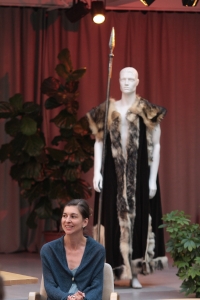 |
| Nicola Raab. Parsifal custom in the background |
"Time turns into space…
On May 30th the Winter Garden of the Estonian National Opera witnessed the second meeting of “Parsifal”-friends. Kristel Pappel, music historian and Wagner specialist, spoke about the musical themes of “Parsifal” in her presentation “Time Turns into Space: Musical Ideas of “Parsifal”“, and Stage Director Nicola Raab introduced her concept of staging.
In her presentation, Kristel Pappel explained the musical-philosophical background of Wagner’s stage dedication play and introduced the characters. In most of his works Wagner uses leitmotifs, a recurring theme, associated with a particular person, place, or idea. Leitmotifs are also an important part of “Parsifal”. The listeners were presented with examples of the most important ones.
Time turns into space…
 |
| Kristel Pappel, Nicola Raab |
Sound examples of leitmotifs – click HERE.
Stage Director Nicola Raab introduced the concept of staging and said that it is a great honour for her to be staging the first “Parsifal” in Estonia and do it in the contemporary environment of Noblessner Foundry. As an answer to the question what would be the difference between staging it in Germany, she explained that in Germany she would have to do something that would surpass all the innovations of the previous productions. There is no such compulsion in Estonia and that allows her to concentrate on the piece itself. “Parsifal” is a very multi-layered opera, and it should be kept in mind that certain aspects change in time. It is necessary to find a version that would apply to contemporary society. Nicola Raab’s goal is to tell the story of “Parsifal” and outline the characters.
 Wagner’s “Parsifal” is a mixture of drama and ritual – Estonian production draws more on the dramatic side. One of the most important aspects is the duality of the Grail and the Spear – the Spear will always be a weapon, even if it is used in self-defence and the Grail will always be a vessel, where something can be put. In explaining the essence of the Grail, Nicola Raab relies foremost on Wagner’s explanations in the music – the Grail feeds the brethren of the Grail, unites them and is the source of their strength. Amfortas and Parsifal are the persons who are most influenced by the Grail – it brings to light different aspects of their characters. One of the questions that intrigues Raab the most is what will happen to Parsifal after the opera ends?
Wagner’s “Parsifal” is a mixture of drama and ritual – Estonian production draws more on the dramatic side. One of the most important aspects is the duality of the Grail and the Spear – the Spear will always be a weapon, even if it is used in self-defence and the Grail will always be a vessel, where something can be put. In explaining the essence of the Grail, Nicola Raab relies foremost on Wagner’s explanations in the music – the Grail feeds the brethren of the Grail, unites them and is the source of their strength. Amfortas and Parsifal are the persons who are most influenced by the Grail – it brings to light different aspects of their characters. One of the questions that intrigues Raab the most is what will happen to Parsifal after the opera ends?Another important aspect is Amfortas’ wound that relates to his unredeemed guilt. He failed to destroy Klingsor’s world and lost the Holy Spear. Klingsor used it to give him a never-healing wound. The guilt of having failed gave him also a psychological wound that keeps him entangled in the past. Amfortas is a character who has no future.
Originally Posted here
More information












